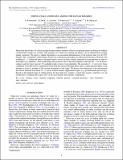TRIPLE-STAR CANDIDATES AMONG THE KEPLER BINARIES
Author(s)
Deck, Katherine M.; Borkovits, T.; Carter, Joshua Adam; El Mellah, I.; Sanchis-Ojeda, R.; Kalomeni, B.; Rappaport, Saul A.; Levine, Alan M.; ... Show more Show less
DownloadRappaport-2013-TRIPLE-STAR CANDIDAT.pdf (2.960Mb)
PUBLISHER_POLICY
Publisher Policy
Article is made available in accordance with the publisher's policy and may be subject to US copyright law. Please refer to the publisher's site for terms of use.
Terms of use
Metadata
Show full item recordAbstract
We present the results of a search through the photometric database of Kepler eclipsing binaries looking for evidence of hierarchical triple-star systems. The presence of a third star orbiting the binary can be inferred from eclipse timing variations. We apply a simple algorithm in an automated determination of the eclipse times for all 2157 binaries. The "calculated" eclipse times, based on a constant period model, are subtracted from those observed. The resulting O – C (observed minus calculated times) curves are then visually inspected for periodicities in order to find triple-star candidates. After eliminating false positives due to the beat frequency between the ~[1 over 2] hr Kepler cadence and the binary period, 39 candidate triple systems were identified. The periodic O – C curves for these candidates were then fit for contributions from both the classical Roemer delay and so-called physical delay, in an attempt to extract a number of the system parameters of the triple. We discuss the limitations of the information that can be inferred from these O – C curves without further supplemental input, e.g., ground-based spectroscopy. Based on the limited range of orbital periods for the triple-star systems to which this search is sensitive, we can extrapolate to estimate that at least 20% of all close binaries have tertiary companions.
Date issued
2013-04Department
Massachusetts Institute of Technology. Department of Physics; MIT Kavli Institute for Astrophysics and Space ResearchJournal
Astrophysical Journal
Publisher
IOP Publishing
Citation
Rappaport, S., K. Deck, A. Levine, T. Borkovits, J. Carter, I. El Mellah, R. Sanchis-Ojeda, and B. Kalomeni. “ TRIPLE-STAR CANDIDATES AMONG THE KEPLER BINARIES .” The Astrophysical Journal 768, no. 1 (April 12, 2013): 33. © 2013 The American Astronomical Society
Version: Final published version
ISSN
0004-637X
1538-4357